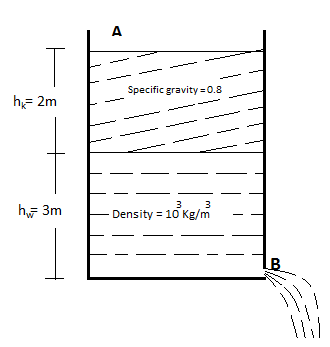
Answer
432.9k+ views
Hint: Here, it is asked to determine the velocity of fluid coming out of the hole. To find out the velocity of fluid flow from an orifice we can use the Bernoulli’s theorem which states that, per unit mass of an incompressible, non-viscous fluid in a streamlined flow, the sum of pressure energy, kinetic energy, and potential energy remains a constant. Here, density and height of water, specific gravity and height of kerosene are given. By substituting it in Bernoulli’s equation, we can find out the velocity.
Formula used:
\[\text{Density of a fluid = specific gravity of fluid }\!\!\times\!\!\text{ density of water}\]
\[{{\text{P}}_{1}}+\dfrac{1}{2}\rho v_{1}^{2}+\rho g{{h}_{1}}={{\text{P}}_{2}}+\dfrac{1}{2}\rho v_{2}^{2}+\rho g{{h}_{2}}\]
\[{{A}_{1}}{{v}_{1}}={{A}_{2}}{{v}_{2}}\]
Complete answer:
Given,
\[\text{Density of water, }{{\rho }_{w}}\text{ = 1}{{\text{0}}^{\text{3}}}\text{Kg/}{{\text{m}}^{\text{3}}}\]
\[g=10m/{{s}^{2}}\]
\[\text{Height of water, }{{\text{h}}_{w}}\text{ = 3m}\]
\[\text{Height of kerosene, }{{\text{h}}_{k}}\text{ = 2m}\]
\[\text{Specific gravity of kerosene = 0}\text{.8}\]
We have,
\[\text{Density of a fluid = specific gravity of fluid }\!\!\times\!\!\text{ density of water}\]
Then,
\[\text{Density of kerosene, }{{\rho }_{k}}\text{ = 0}\text{.8 }\!\!\times\!\!\text{ 1000=800}\]

We have Bernoulli’s equation,
\[{{\text{P}}_{1}}+\dfrac{1}{2}\rho v_{1}^{2}+\rho g{{h}_{1}}={{\text{P}}_{2}}+\dfrac{1}{2}\rho v_{2}^{2}+\rho g{{h}_{2}}\] --------- 1
Here we have,
\[{{P}_{1}}={{P}_{2}}={{P}_{0}}\](Both the points are open to atmosphere) ------- 2
\[\rho ={{\rho }_{k}}+{{\rho }_{w}}\] ------- 3
\[{{\text{h}}_{\text{1}}}\text{= }{{\text{h}}_{w}}+{{h}_{k}}\] ------- 4
Since the hole is at the bottom of tank,
\[{{h}_{2}}=0\] -------- 5
When hole is opened, fluid coming out from the hole will be water. Hence, we need to use the formula for kinetic energy of water in equation 1.
Apply Bernoulli’s theorem at point A and B. And substitute 2, 3, 4, 5 and 6 in equation 1 we get,
\[{{\text{P}}_{0}}+\dfrac{1}{2}{{\rho }_{w}}v_{1}^{2}+\left( {{\rho }_{w}}g{{h}_{w}}+{{\rho }_{k}}g{{h}_{k}} \right)={{\text{P}}_{0}}+\dfrac{1}{2}{{\rho }_{w}}v_{2}^{2}\] --------- 7
Applying continuity equation at the hole and at the top of tank,
\[{{A}_{1}}{{v}_{1}}={{A}_{2}}{{v}_{2}}\]
Where,
\[{{\text{A}}_{\text{1}}}\text{- Area of the top portion}\]
\[{{\text{A}}_{2}}\text{- Area of hole}\]
\[{{v}_{\text{1}}}\text{- Velocity of the fluid at point A}\]
\[{{v}_{2}}\text{- Velocity of the fluid at point B}\]
Here, \[{{\text{A}}_{\text{1}}}\] is much greater than \[{{\text{A}}_{2}}\]
Then,
\[{{v}_{1}}\approx 0\]
Substituting the values of \[{{\text{h}}_{\text{1}}}\text{,}{{\text{h}}_{\text{2}}}\text{,}{{\text{ }\!\!\rho\!\!\text{ }}_{k}}\text{,}{{\rho }_{w}}\text{,g and }{{\text{v}}_{1}}\] in equation 7, we get,
\[3\times {{10}^{3}}\times 10+2\times 0.8\times {{10}^{3}}\times 10=\dfrac{1}{2}\times {{10}^{3}}\times v_{2}^{2}\]
\[v_{2}^{2}=92\]
\[{{v}_{2}}=\sqrt{92}=9.6m/s\]
So, the correct answer is “Option B”.
Note:
When two fluids with different densities are mixed, denser fluid will settle at the bottom. Here the water has a density higher than kerosene. Hence water settles at the bottom and when the hole is opened, water starts flowing out first.
Formula used:
\[\text{Density of a fluid = specific gravity of fluid }\!\!\times\!\!\text{ density of water}\]
\[{{\text{P}}_{1}}+\dfrac{1}{2}\rho v_{1}^{2}+\rho g{{h}_{1}}={{\text{P}}_{2}}+\dfrac{1}{2}\rho v_{2}^{2}+\rho g{{h}_{2}}\]
\[{{A}_{1}}{{v}_{1}}={{A}_{2}}{{v}_{2}}\]
Complete answer:
Given,
\[\text{Density of water, }{{\rho }_{w}}\text{ = 1}{{\text{0}}^{\text{3}}}\text{Kg/}{{\text{m}}^{\text{3}}}\]
\[g=10m/{{s}^{2}}\]
\[\text{Height of water, }{{\text{h}}_{w}}\text{ = 3m}\]
\[\text{Height of kerosene, }{{\text{h}}_{k}}\text{ = 2m}\]
\[\text{Specific gravity of kerosene = 0}\text{.8}\]
We have,
\[\text{Density of a fluid = specific gravity of fluid }\!\!\times\!\!\text{ density of water}\]
Then,
\[\text{Density of kerosene, }{{\rho }_{k}}\text{ = 0}\text{.8 }\!\!\times\!\!\text{ 1000=800}\]

We have Bernoulli’s equation,
\[{{\text{P}}_{1}}+\dfrac{1}{2}\rho v_{1}^{2}+\rho g{{h}_{1}}={{\text{P}}_{2}}+\dfrac{1}{2}\rho v_{2}^{2}+\rho g{{h}_{2}}\] --------- 1
Here we have,
\[{{P}_{1}}={{P}_{2}}={{P}_{0}}\](Both the points are open to atmosphere) ------- 2
\[\rho ={{\rho }_{k}}+{{\rho }_{w}}\] ------- 3
\[{{\text{h}}_{\text{1}}}\text{= }{{\text{h}}_{w}}+{{h}_{k}}\] ------- 4
Since the hole is at the bottom of tank,
\[{{h}_{2}}=0\] -------- 5
When hole is opened, fluid coming out from the hole will be water. Hence, we need to use the formula for kinetic energy of water in equation 1.
Apply Bernoulli’s theorem at point A and B. And substitute 2, 3, 4, 5 and 6 in equation 1 we get,
\[{{\text{P}}_{0}}+\dfrac{1}{2}{{\rho }_{w}}v_{1}^{2}+\left( {{\rho }_{w}}g{{h}_{w}}+{{\rho }_{k}}g{{h}_{k}} \right)={{\text{P}}_{0}}+\dfrac{1}{2}{{\rho }_{w}}v_{2}^{2}\] --------- 7
Applying continuity equation at the hole and at the top of tank,
\[{{A}_{1}}{{v}_{1}}={{A}_{2}}{{v}_{2}}\]
Where,
\[{{\text{A}}_{\text{1}}}\text{- Area of the top portion}\]
\[{{\text{A}}_{2}}\text{- Area of hole}\]
\[{{v}_{\text{1}}}\text{- Velocity of the fluid at point A}\]
\[{{v}_{2}}\text{- Velocity of the fluid at point B}\]
Here, \[{{\text{A}}_{\text{1}}}\] is much greater than \[{{\text{A}}_{2}}\]
Then,
\[{{v}_{1}}\approx 0\]
Substituting the values of \[{{\text{h}}_{\text{1}}}\text{,}{{\text{h}}_{\text{2}}}\text{,}{{\text{ }\!\!\rho\!\!\text{ }}_{k}}\text{,}{{\rho }_{w}}\text{,g and }{{\text{v}}_{1}}\] in equation 7, we get,
\[3\times {{10}^{3}}\times 10+2\times 0.8\times {{10}^{3}}\times 10=\dfrac{1}{2}\times {{10}^{3}}\times v_{2}^{2}\]
\[v_{2}^{2}=92\]
\[{{v}_{2}}=\sqrt{92}=9.6m/s\]
So, the correct answer is “Option B”.
Note:
When two fluids with different densities are mixed, denser fluid will settle at the bottom. Here the water has a density higher than kerosene. Hence water settles at the bottom and when the hole is opened, water starts flowing out first.
Recently Updated Pages
How many sigma and pi bonds are present in HCequiv class 11 chemistry CBSE

Mark and label the given geoinformation on the outline class 11 social science CBSE

When people say No pun intended what does that mea class 8 english CBSE

Name the states which share their boundary with Indias class 9 social science CBSE

Give an account of the Northern Plains of India class 9 social science CBSE

Change the following sentences into negative and interrogative class 10 english CBSE

Trending doubts
Difference between Prokaryotic cell and Eukaryotic class 11 biology CBSE

Which are the Top 10 Largest Countries of the World?

Differentiate between homogeneous and heterogeneous class 12 chemistry CBSE

Fill the blanks with the suitable prepositions 1 The class 9 english CBSE

Difference Between Plant Cell and Animal Cell

Give 10 examples for herbs , shrubs , climbers , creepers

The Equation xxx + 2 is Satisfied when x is Equal to Class 10 Maths

Write a letter to the principal requesting him to grant class 10 english CBSE

Change the following sentences into negative and interrogative class 10 english CBSE



